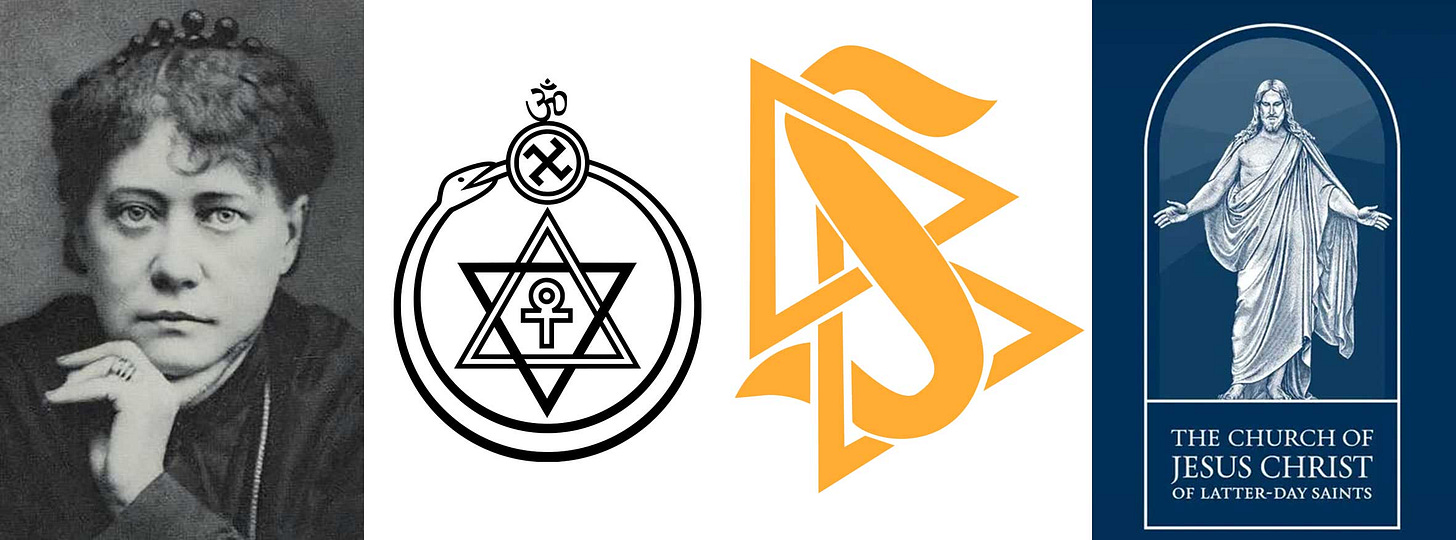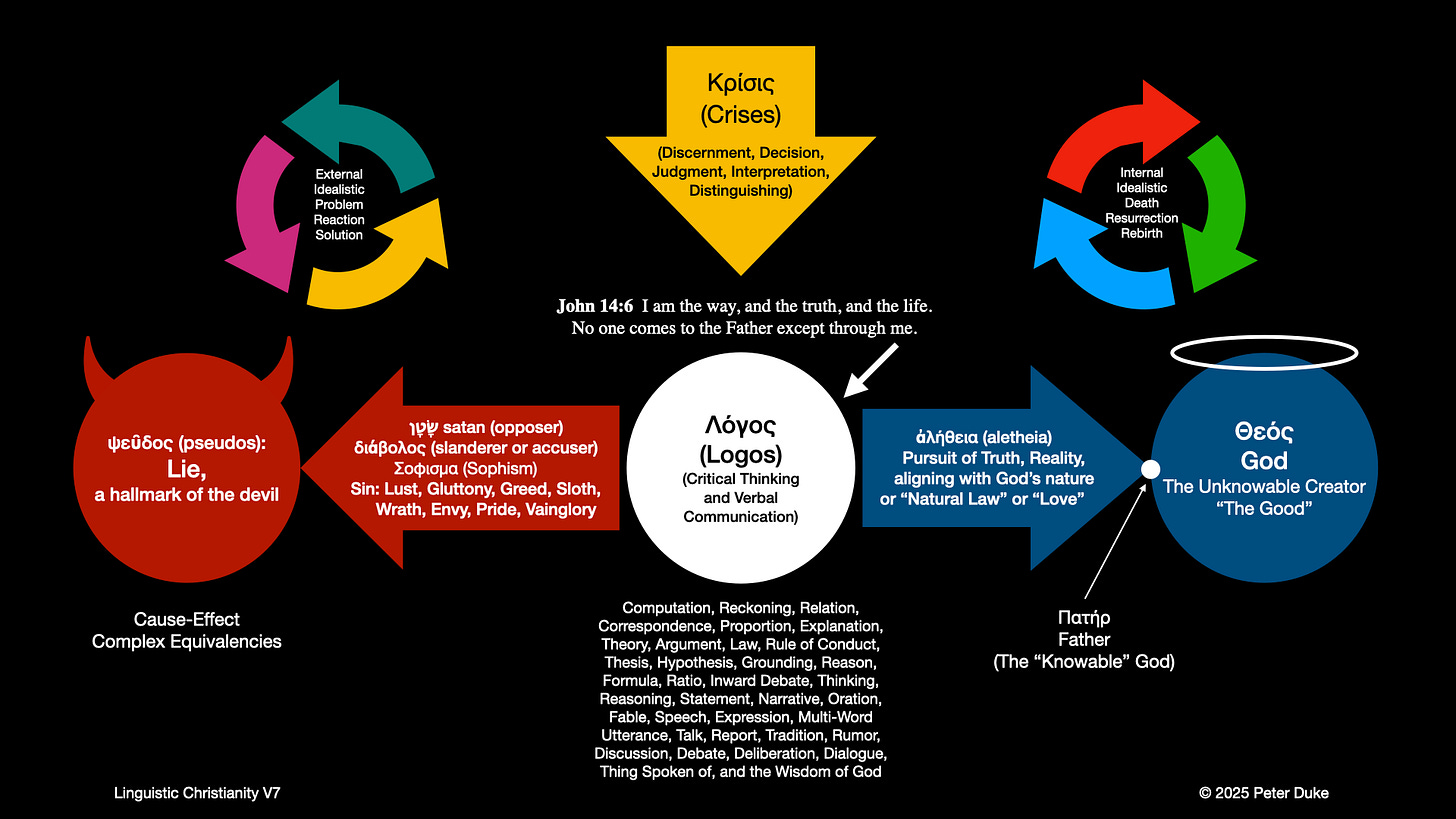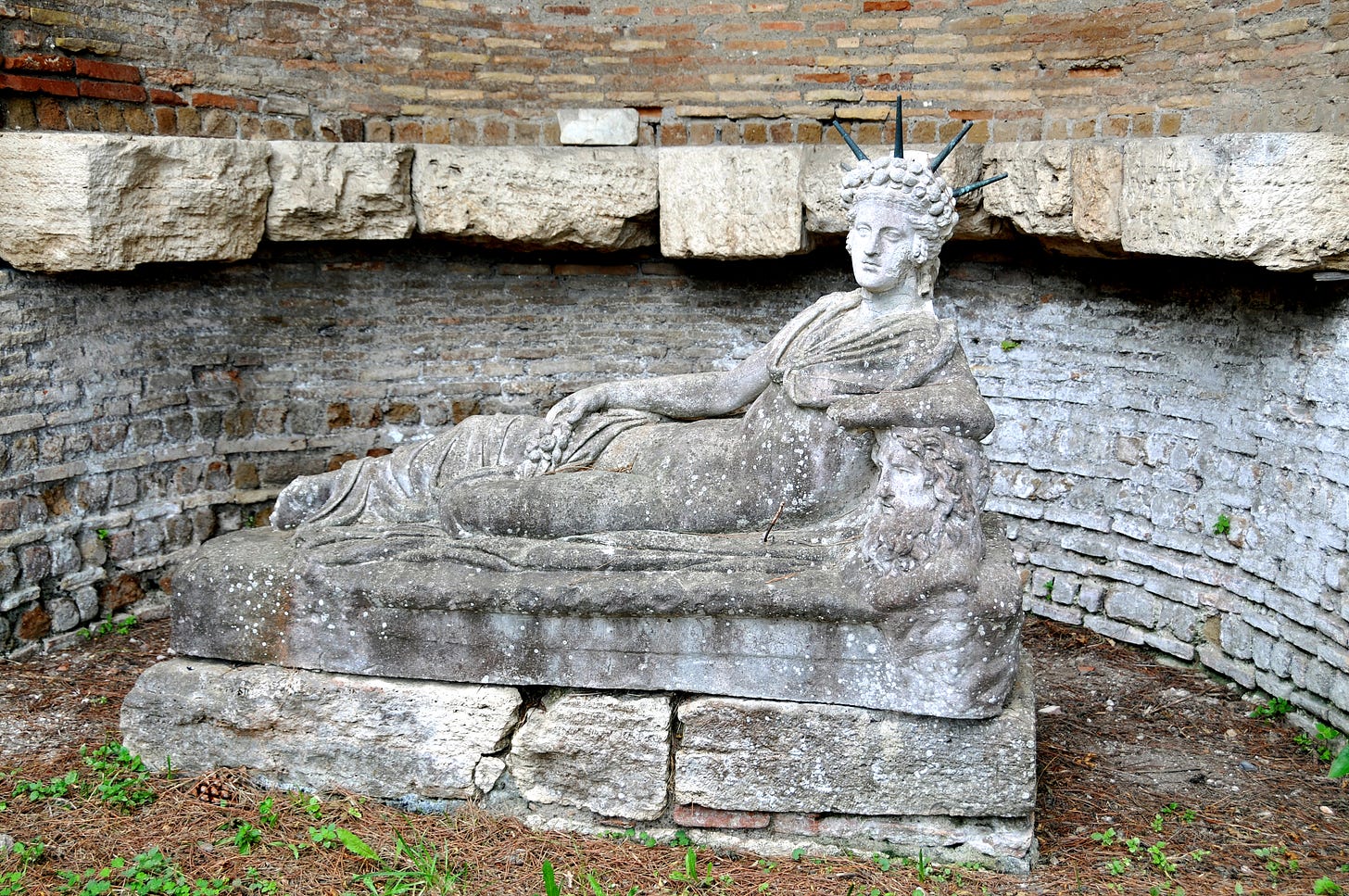Updated: If This Does Not Challenge Your Faith...
Separating Jesus from the Church

Introduction
Linguistic Christianity is a dogma-free, structurally grounded analysis of the words and patterns presented in the witness gospels. It is neutral with respect to religious belief. Its framework does not require the reader to believe that Jesus of Nazareth was the Son of God, nor does it reject that belief. Instead, it begins with a simpler and more universally accessible claim: that the words attributed to Jesus — when read through the lens of Greek linguistics, epistemology, and dialogue structure — reveal a functional system for navigating truth.
This work presents a developing theory. It draws from linguistic observation, epistemological analysis, and historical records. The goal is not to promote a new theology, but to clarify how the original message attributed to Jesus functioned as a tactical, liberatory method — one that directly threatened systems of control.
The conclusions presented here will unsettle both believers and skeptics. That is expected. What matters is not how people feel about the claims, but whether those claims are structurally sound. This investigation follows λόγος (logos) — language, reason, proportion — and κρίσις (crises) — discernment, judgment, separation. These tools are sufficient when used in alignment with God, Natural Law, or Truth.
The primary textual focus is on the witness gospels. That is a methodological decision, not a spiritual one. Non-witness texts may be sincere reflections of later believers, but they are not direct testimony. And since this project deals in the mechanics of speech and interpretation, controlling for time, perspective, and language is essential.
The central claim is simple:
Jesus taught a linguistic method.
It was not mystical.
It was not abstract.
It was a practical, procedural toolset for epistemic clarity and personal transformation.
It used language to reframe perception in the direction of God/Truth/Natural Law — what the American Founders later called “the Laws of Nature and Nature’s God.”
Its efficacy had immediate social, psychological, and political implications.
This method was recognized as a threat. The people who managed power — both temple priests and Roman administrators — saw it for what it was: a distributed system of epistemological autonomy. It allowed individuals to access truth without permission. It bypassed hierarchy. It spread from mouth to mouth, through active inquiry and disciplined speech. That method had to be stopped — or at least controlled.
And so it was.
What came next was not an evolution of the message. It was a containment operation. The oligarchs who managed the empire institutionalized a tried-and-true method, burying the message in mystery. They renamed, reframed, and redirected it. In doing so, they preserved the icon while disabling its function.
This is not a theological judgment.
It is a structural analysis.
And it can be tested by anyone who understands how language works.
It is self-evident, like John 1:1.
(once one understands the meaning of the Greek word λόγος).
What follows is not doctrine. It is a map of how language, belief, and power interact. It is offered as a tool for anyone willing to think for themselves. The aim is not to persuade, but to reveal a pattern.
Thanks to my readers' generosity, all my articles are free to access. Independent journalism, however, requires time and investment. If you found value in this article or any others, please consider sharing or even becoming a paid subscriber, who benefits by joining the conversation in the comments. I want you to know that your support is always gratefully received and will never be forgotten. Please buy me a coffee or as many as you wish.
I. Jesus’ Method Was a Language System — Not a Religion
Jesus didn’t teach theology. He modeled a way of speaking and thinking — a method grounded in active inquiry, not dogma. His conversations, parables, and rebukes were structured acts of reframing. Each was designed to interrupt distorted perception and redirect the listener toward what is self-evident, proportionate, and directionally aligned with a reality consistent with God/Truth/Natural Law.
His approach was linguistic, procedural, and inherently viral.
It spread through self-evident recognition.
The structure of his speech followed a clear logic: ask questions, identify assumptions, separate claims from linguistic patterns. This is what the Greeks called λόγος (logos, /LOH-gos/): not just “word,” but reason, structure, and proportion. Jesus paired it with κρίσις (krisis, /KREE-sees/): judgment, discernment, the ability to distinguish.
The miracle of these linguistic tools was the transformation of the self through the revelation of self-evident Truth.
“crises” (κρίσις) is a great example of how a word has changed its meaning in translation. In Greek, its closer to discernment, separating, distinguishing.
This method wasn’t abstract.
It was concrete.
Every time Jesus confronted a Pharisee, challenged a crowd, or taught a disciple, he enacted a disciplined process. He used λόγος (logos) to untangle deception and κρίσις (crisis) to expose its root. That’s how he revealed the difference between what is imposed by men and what is aligned with Natural Law — what the American Founders later called “the Laws of Nature and Nature’s God.”
The pattern is not hard to see. When λόγος and κρίσις are used in the direction of love (another word that needs unpacking) — measured action oriented toward God/Truth/Natural Law — they result in more clarity, as one moves closer to God/Truth/Natural Law.
When λόγος is applied in the direction opposing God/Truth/Natural Law – without κρίσις (crisis) – the results are σοφίσμα (sophisma, /so-FEES-mah/): deception dressed as wisdom.
The opposing direction is “satan” in Hebrew שָׂטָן.
Sin is a directional distortion.
Jesus wasn’t practicing a mystery.
He was teaching a principled operating system.
II. Magic Is the Oldest Trick in the Book
Magic isn’t about spells or mysticism.
It’s a structured manipulation of belief.
At its core, magic is the art of hiding the obvious — of turning what is tangible and self-evident into something mysterious, untouchable, and controlled.
This tactic has been used for millennia by those who rule, not just in temples and courts, but in financial systems and bureaucracies. The trick is always the same: insert a layer of abstraction between people and truth, then claim exclusive authority to interpret what lies beyond.
Ancient priests used knowledge of astronomy to stage predictions. Oracles delivered answers based on intelligence networks, not divine insight. Ritual, secrecy, and performance create the illusion of supernatural access — but the knowledge is terrestrial, manipulated, and deliberately obscured.
Jesus broke that system. He taught that truth does not require mystification. It requires clarity. It requires disciplined language — λόγος (logos, /LOH-gos/) — and discernment — κρίσις (krisis, /KREE-sees/).
Magic, by contrast, uses misdirection, theatrical ritual, and specialized language to create awe and dependency.
Belief in money — especially in debt-based financial systems – like the Federal Reserve Bank, The Bank of International Settlements, and The World Bank, et al. — is a modern form of magic.
Currency has no inherent value.
It represents value.
Yet entire societies operate on faith in this representation.
Contracts, laws, and legal fictions operate in the same way.
These are symbolic systems enforced by collective belief and institutional power.
When these things are out of alignment with God/Truth/Natural Law, they are all forms of deception.
When the people who control power structures manipulate language to obscure reality, they are practicing a form of epistemological warfare. This includes central banks, legal regimes, universities, think tanks, and ideological institutions, along with institutionalized religion.
Secret societies, occult orders, and so-called “mystery schools” have long capitalized on this dynamic. They promise access to hidden knowledge but deliver pseudo-reality — ψεῦδος (pseudos, /PSYOO-doss/, falsehood) — as a means of capturing minds and redirecting loyalty to oligarchic interests.
This is tactical. The manipulation of language to distort reality is the oldest weapon of control. It is also the one Jesus dismantled, step by step, in his public ministry. He did it with reason. With precision. With truth spoken plainly. He used words in an active and participatory manner.
III. The Epistemological Crisis of Empire
Those who governed the Roman provinces — both the administrative elite and the temple priesthoods — understood what Jesus was doing. His speech patterns were not religious innovations. They were epistemological weapons. He was dismantling the architecture of control by teaching people how to think clearly and act freely.
Jesus did not speak against law. He spoke against mystified authority — against systems, like the word “Liberty”, that reclassified natural rights as imperial privileges.
The ruling class had built its power on a semantic trick: redefine liberty as something granted by the empire, not something intrinsic to the individual.
For the establishment rulers, Jesus teachings were an epistemological crisis.
Jesus ignored that framing entirely.
He taught freedom — not liberty.
Freedom is unmediated.
The definition of who defines one’s liberty if often shrouded in semantic nonsense.
It is the right to align thought, speech, and action with what is true, without permission.

Liberty, as enforced by the empire, was conditional — a reward for obedience, not a principle of self-governance. The distinction was tactical doctrine developed by Fabius Maximus and perpetrated on Western Civilization.
As documented in Rome’s Epistemological Warfare Against the Greeks, the imperial project had long depended on manipulating the meanings of words. Greek concepts like
πολιτεία (politeia, /po-lee-TAY-uh/, civic structure or constitutional order),
φύσις (physis, /FOO-sees/, nature or the inherent order of things)
…were redefined to suit bureaucratic administration.
Jesus reasserted their core function: direct access to reality through disciplined reason.
His method activated epistemic autonomy. People began to speak differently, think differently, act with confidence rooted in truth rather than fear.
This made them difficult to manage using axioms, rhetoric and other forms of reality-manipulating language.
Jesus' teaching posed a problem. And the response followed a familiar pattern — what later theorists like Hegel would formalize as “dialectic”.
Problem: autonomous thinking.
Reaction: crucifixion.
Solution: reframe the teaching, abstract the figure, insert an imperial mediator between man and God.
That solution would only be effective if Jesus' method worked. And it did. The entire containment effort — legal, religious, and symbolic — was a response to a discipline that spread organically. Jesus taught something that couldn’t be ignored, and it was growing exponentially.
IV. The Co-Opting of Jesus’ Method
Those responsible for managing imperial and religious power did not misinterpret Jesus. They understood exactly what he was doing. His method worked. It spread from speaker to listener, who in turn became a speaker, and moved from group to group, disrupting the fragile consensus that kept people obedient. His teachings offered a procedural alternative to hierarchy. And that made them dangerous.
So Jesus’ method and message had to be neutralized.
This was done through co-optation.
What began as a distributed, bottom-up practice of cognitive liberation was repackaged as a top-down religious system.
Those in power did not destroy the message — they reframed it.
The oligarchs and their handlers buried it in metaphysics. They turned a participatory model into a performance. They built temples around it, then claimed to own the keys.
The tactical name for this maneuver is hermeneutics. By redefining key terms and embedding Jesus’ speech in layers of interpretation, power brokers created the appearance of reverence while disabling access to the method itself.
This is epistemological warfare.
The success of this strategy rested on one fact: the method worked. It spread in spite of suppression — and, paradoxically, was amplified by it. The crucifixion itself became an epistemological Streisand Effect: an attempt to silence the message that instead publicized it. His death gave attention to the very method the ruling class sought to contain.
What we now call “Christianity” was, at its origin, a revolutionary, viral phenomenon. It spread because of epistemological clarity. It challenged the authority of both the Temple and the Empire — and for that, it had to be co-opted and institutionalized.
By mystifying Jesus, they made him untouchable. By reframing his message as abstract theology, they turned a participatory process into a performance managed by elites. In doing so, they re-established control over the frame. But they could not erase the blueprint.
V. Mystification Through Translation and Theology
The next layer of containment came through language itself. The control of interpretation required more than institutions — it required the deliberate distortion of meaning. This happened through translation.
Key Greek terms were not simply converted into Latin; they were reframed.
λόγος (logos, /LOH-gos/) became Verbum, flattening its complex meaning — structure, speech, reason — into a vague reference to “word.”
μετανοεῖτε (metanoeite, /meh-tah-NO-ee-teh/) meant to reconsider or change one’s mind — a cognitive shift — became Poenitentiam agite in the Vulgate: “do penance,” reframing an internal transformation as an external ritual act.
ἐκκλησία (ekklēsia, /ek-klay-SEE-ah/) meant an assembly or gathering — a called-together body — became ecclesia in the Latin Vulgate, preserving the sense of a community or congregation, but over time in Latin usage came to signify the institutional Church, a shift that passed into English as “Church,” reframing a participatory body into a centralized authority.
πίστις (pistis, /PIS-tees/) originally denoted trust, reliability, or conviction — often grounded in evidence, relationship, or proof. In the Latin Vulgate, it was translated as fides, meaning loyalty, trust, or good faith. Over time, the English word “faith” came to represent a more abstract theological category, sometimes implying belief apart from reason — a semantic drift not found in the original Greek or Latin.
Each of these shifts displaced the method Jesus modeled. Instead of internal, revelatory processes, these translations imposed external, rule-based systems. The result was the replacement of clarity with ritual, and process with doctrine.
Even the word “love” was obscured. In Greek, love was not a single emotion. It was a spectrum of relational directionality:
Latin collapsed these into:
Eventually all categories were reduced into the single, unqualified term 'love.'
What Jesus taught as an action — a disciplined commitment to aligning one's will with God/Truth/Natural Law — was reframed as a vague feeling.
Direction was lost.
The ethical function of ἀγάπη (agapē, /ah-GAH-pay/, moral and selfless love aligned with will) disappeared.
Even thinkers like Augustine and Aquinas, influential in shaping Western Christian doctrine, were operating without access to the original Greek. Their theological systems were built on Latin renderings — distorted reflections of the original speech acts.
Without the structure of λόγος and κρίσις, their models leaned toward abstraction and submission rather than dialogue and discernment.
This was not an accident.
It was an epistemological sleight-of-hand.
By altering definitions at the linguistic level, institutions could preserve the icon of Jesus while quietly removing the method he practiced. In place of applied discernment, believers were offered theology. In place of reframing, they were taught obedience. What began as a clear and practical process became wrapped in semantic fog.
VI. From Viral Movement to Imperial Church
Jesus built relationships. His method spread through dialogue — small groups, open conversations, encounters in public space. It was not limited by hierarchy or geography. It replicated through λόγος, through the active use of speech, question, and response.
The small group method was inherently difficult to control.
The larger the group, the more danger. Put twelve people in a room, and there could be existential trouble — not because of what they might say, but because one of them might be Judas.
The risk of betrayal was always present. But so was the possibility of awakening. The message traveled light, and it traveled fast.
That structure — horizontal, distributed, and viral — posed a threat to anyone managing large systems of control. It disrupted uniformity. It seeded critical thought.
It could not be reliably surveilled.
So it had to be converted.
Those in charge of imperial administration saw the potential. Instead of eradicating the movement, they institutionalized it. They turned a grassroots network of epistemic empowerment into a centralized hierarchy of ritual and obedience. They framed Jesus not as a guide to freedom, but as a symbol to be worshipped from a distance.
The method was preserved in fragments — but surrounded by fences (or fasces).
Rituals replaced inquiry.
Dogma replaced reframing.
Authority replaced dialogue.
Historians like Arnold Toynbee — who was closely associated with Alfred Milner and the Rhodes Round Table — later described Christianity as a form of civilizational glue. That may have been true. But it also reveals the strategic value of religious containment: belief systems are powerful tools for stabilizing populations, especially when they appear to challenge power while secretly reinforcing it.
The empire did not crush the movement. It absorbed it. And in doing so, it neutralized the most dangerous part: the method.
VII. East vs. West: Suppression of λόγος
The division between Eastern and Western Christianity was epistemological.
In the East, much of the cognitive structure of Jesus’ original method was preserved, because Greek was their native language. The Eastern tradition retained participatory reasoning and an emphasis on transformation of the self through practice and contemplation. Jesus’ method was still seen as a path — an active, procedural way to align one’s will and speech with God/Truth/Natural Law.
In the West, that path was largely buried. The Latin-speaking Church replaced method with metaphysics. What had been direct and practical was turned into abstraction. Mystery, not participation, became the center of religious life.
This was no accident. The Fourth Crusade and the Council of Florence were epistemological conquests. As historian Webster Tarpley has shown, the sack of Constantinople was engineered by Venetian intelligence networks acting on behalf of oligarchic interests. The goal was control — not only of territory, but of worldview1.
When the Eastern Church fell under Latin influence, the epistemological war was complete. The hierarchical West began to dominate the narrative, imposing its language, structures, and interpretive filters over what had once been a dynamic and internally self-regulating process of spiritual cognition.
This structure was refined by the Jesuit Order. Their methods included loyalty oaths, elite education, and surveillance. They turned epistemology into a weapon. Instead of encouraging inquiry, they taught obedience. Instead of fostering κρίσις (crisis), they trained rhetorical defense of dogma.
Dr. Wolfgang Smith, a Catholic, has illuminated a core aspect of this divergence. In Eastern systems, spiritual development is often seen as the annihilation of the self. Nirvana, Moksha, the void — these are states of dissolution. But Jesus taught the perfection of the self, not its erasure. His use of λόγος (logos) and κρίσις (crises) was not meant to disappear the individual, but to refine it — to bring it into alignment with God.
Smith’s insight confirms what the Eastern Church preserved and the Western Church obscured: that Jesus taught transformation, not submission. As he states,
"Christ brought into the world a new eschata (ἔσχατον meaning 'final things')2, a new way of seeing God, a way in which our humanity is not burnt up... with his resurrection, a new religion came into the world... it offers us a life eternal as human beings. Our humanity becomes, in a certain sense, deified through union with Christ"3.
A participatory process rooted in cognitive rigor — not blind surrender to a mystery.
Modern attempts to synthesize Eastern and Western religion — such as Theosophy — have often blurred this distinction. Theosophy promotes a metaphysical worldview that draws from Eastern traditions of self-annihilation while attempting to co-opt the symbolic vocabulary of Christianity. This fusion obscures the foundational divergence: Jesus taught the perfection of the self through the application of λόγος and κρίσις.

Theosophy, by contrast, invites mystical dissolution rather than disciplined refinement. In that way, Theosophy mirrors the Empire’s original tactic: bury the method beneath abstraction, and replace process with passive transcendence.
VIII. Recovering λόγος: Separating Wheat from Chaff
The Empire had a problem: Jesus' teaching worked. His linguistic method exposed the machinery of control, empowering individuals to think critically and align with Natural Law. In response, the oligarchs and their handlers executed a dialectical containment strategy: problem, reaction, solution. The problem was the viral spread of epistemic clarity. The reaction was crucifixion. The solution was theological — a reframing of Jesus as a distant, transcendent abstraction, and the installation of institutional authority between God and man.
This maneuver inverted the internal Paschal structure. Jesus taught transformation through a process of internal death, resurrection, and rebirth — a reformation of belief through λόγος and κρίσις. This transformation process is anointed as complete each time. The Greek word for anointment is Χριστός (Christos, /khris-TOSS/). In Hebrew, the equivalent is מָשִׁיחַ (Mashiach), from which we get Messiah. Χριστός is a past participle that indicates a completed action — one who has been anointed. It aligns with the Paschal process: the individual who has undergone cognitive death, reframing, and resurrection into alignment with λόγος and κρίσις is metaphorically “anointed” — that is, Christos.
“Christianity” is the ongoing discipline – through the applied processes of λόγος and κρίσις – through which the self dies (as on the cross), is resurrected and reborn with an understanding of the world that is more in line with God/Truth/Natural Law, and thereby anointed.
But in response to Jesus’ distributed lessons in this universal and God-given ability, the imperial solution redirected attention outward, replacing that inner movement with priestly mediation and ritual submission.
The internal Paschal process Jesus taught — death, resurrection, and rebirth of the self through λόγος (logos, /LOH-gos/) and κρίσις (krisis, /KREE-sees/) — was replaced by an externalized structure we now label “Hegelian”.
Problem, reaction, solution.
The problem was epistemic autonomy.
The reaction was violence.
The solution was institutional authority interceding to represent God.
What had been a path of self-refinement became a spectacle of obedience. The transformation moved from internal judgment to external control.
The impact was not temporary.
It structured centuries of religious control.
And even later movements like Protestantism — though aimed at reform — often repeated the same error: rejecting Rome without recovering λόγος (logos).
They dismantled hierarchy, but failed to retrieve the method.
What resulted was not clarity, but fragmentation.
Schism without structure.
The way forward is not further division.
It is recovery.
What Jesus taught was a method: disciplined language and precise discernment. λόγος (logos) and κρίσις (crises) are not abstract theological concepts. They are procedural tools — available to anyone willing to use them.
What has long been called “faith” is better understood as a trained capacity to reframe perception in alignment with what is true. Not blind belief, but conscious orientation. Not submission, but participation.
To recover λόγος is to recover agency.
To recover κρίσις is to recover discernment.
These are not luxuries.
They are necessities.
In a world shaped by weaponized language and epistemological confusion, they are our most powerful instruments of resistance.
IX. Conclusion
The illusion engineered by those in power is a magician’s trick. It turns plain truth into mystical confusion through misdirection, semantic manipulation, and ritualized awe. A functional method — practical, repeatable, human — is wrapped in abstraction and rebranded as mystery. That’s the move.
The result is epistemological confusion. By inserting mistranslation, redirection, and theological fog into the original message, Empire actors transformed a system of liberation into a mechanism of control. Good ideas were co-mingled with bad. Truth was preserved in form but emptied in function.
This distortion has caused generations to reject Jesus outright — not because of what he taught, but because of how that teaching was framed. The phrase “throwing out the baby with the bathwater” applies literally here. The baby is Jesus' method. The bathwater is Imperial Christianity. To understand Jesus’ linguistic meaning, they must be separated.
Even Protestant reformers — though often sincere — have added layers of confusion. By rejecting authority without recovering method, they created fragmentation rather than clarity. Reformation without λόγος is just another dialectic. It solves little.
The tool for recovery is language.
Linguistics gives us the power to separate wheat from chaff. If we understand how language is used to frame experience — and how epistemology can either reveal or obscure reality — we can reclaim the method Jesus taught.
He modeled the way.
Jesus stood before the full weight of institutional power and spoke clearly, using λόγος and κρίσις to realign the frame of reality and was anointed in Χριστός.
That example is not abstract.
It is procedural.
And it is available to all of us now.
Apply λόγος.
Practice κρίσις.
Be anointed in Χριστός.
Choose freedom.
Understand the difference between freedom and liberty.
Ask who or what it comes from?
Choose God.
They can’t stop the signal.
eschata, /ES-khah-tah/, plural of ἔσχατον (eschaton, /ES-khah-ton/) (meaning 'final things')













You have developed a concise way of translating our everyday experience of life into a method to critically interpret what is happening to us in all areas of life.
With it, we can begin to open ourselves up to looking deeper into the subtle propaganda that is infused in our politics, finance and religious language.
I think your "working theory", if given a wider audience, can be used to save us from the rising technocracy that is about to descend on humanity.
I pray that there will be enough of us who can begin "using λόγος and κρίσις to realign the frame."
I don’t find this challenging at all, Peter. I am a Jesus follower but do not attend a traditional denominational church. Were I Catholic, Lutheran, Baptist, etc. all of whom have centralized authorities that determine church teachings, I might be resistant to this message. But because my congregation is independent, the authority becomes God’s inspired word only. And I don’t always agree with the pastor’s take on on certain doctrinal issues. Although he has more formal theological education than I have, I am free to disagree on tertiary matters that are non-salvation issues. Christs message was simple, love God and love people (agape) and accept the only true way to the Father is through the Son. You don’t need to be over-educated to understand that.